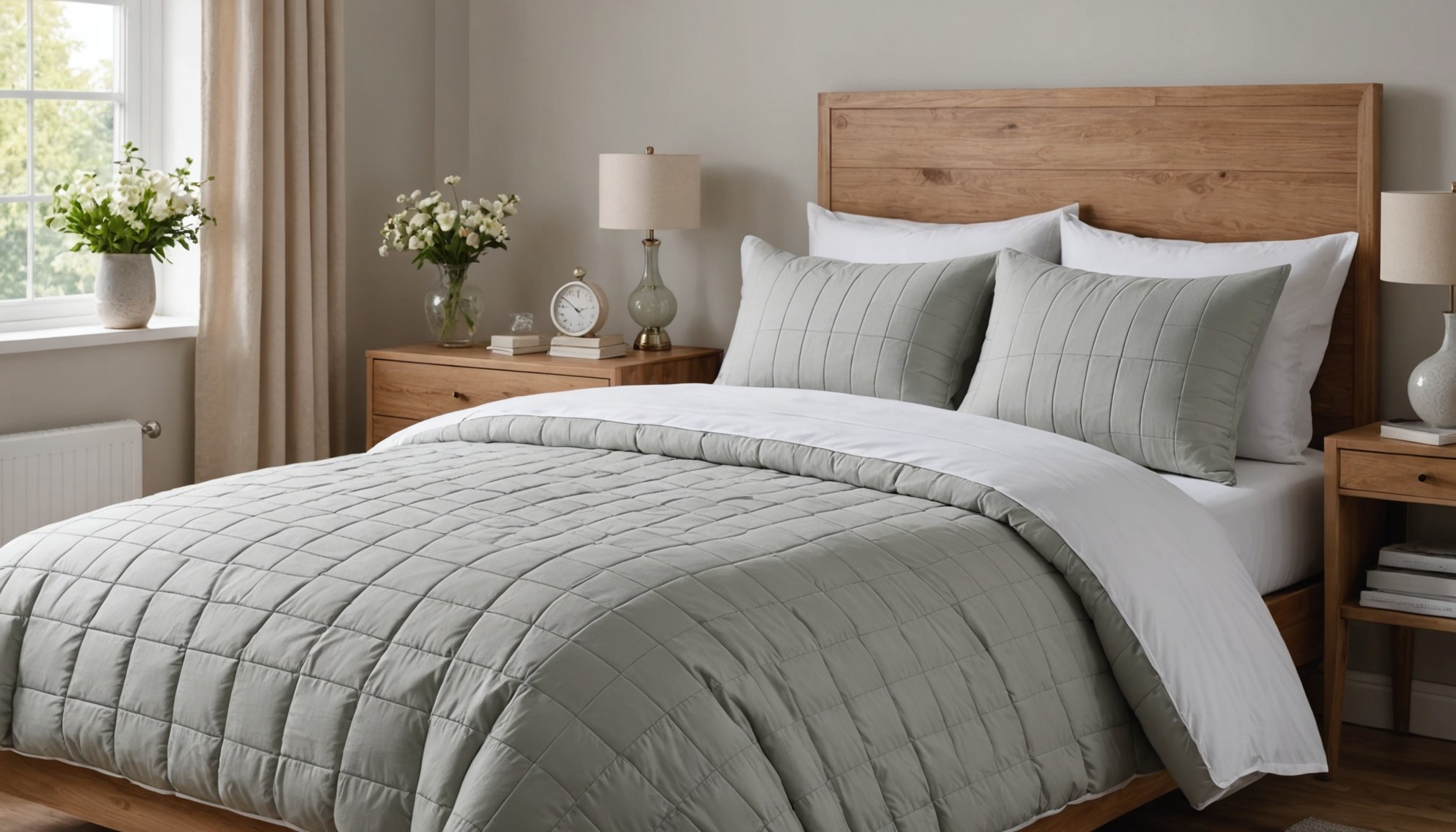Sleep should be the most peaceful and restful time of the day. However, for those who suffer from allergies, it can turn into a nightmare. An invisible army of allergens lurks in your bedding, wages war with your immune system and interrupts your sleep. By choosing hypoallergenic materials for your bedding, you can significantly reduce these nocturnal battles and improve the quality of your sleep. But with so many options available, how do you decide what’s best for you? We will delve into the world of hypoallergenic fabrics to help you make an informed choice.
Hypoallergenic Fabrics: The Key to an Allergen-Free Sleep Environment
Before diving into the specifics, it’s important to understand the term "hypoallergenic". It signifies materials that are less likely to cause allergic reactions. When it comes to bedding, these fabrics help reduce allergens such as dust, mites, and other microscopic particles that can disrupt your sleep and irritate your skin.
Avez-vous vu cela : What are the top tips for successfully incorporating a mezzanine in a UK loft conversion?
This is particularly relevant in the UK, where according to the British Skin Foundation, at least one in four people suffer from an allergy at some point in their lives. The cold and damp climate, especially in winter months, makes bedrooms a fertile ground for dust mites and mould, the most common allergens.
Hypoallergenic fabrics are not a cure-all solution, but they can significantly reduce allergen levels in your bed, providing a more comfortable, uninterrupted sleep.
A lire aussi : Top UK Native Plants for Effortless Gardening: Your Guide to a Low-Maintenance Oasis
Linen: An Ancient Fabric with Modern Allergen-Resistant Properties
If you’re thinking about hypoallergenic bedding, linen should be on your list. Made from the flax plant, this fabric has been in use for thousands of years. It’s breathable, absorbent, and quick to dry. These qualities make it unfavourable for dust mites and mould, which thrive in warm, damp environments.
Linen is also known for its durability and longevity. It gets softer and more comfortable with each wash, making it an excellent investment. Its lightweight, crisp feel is especially beneficial during the hot UK summers, providing a cool and comfortable sleep surface.
One thing to remember about linen is that it tends to wrinkle easily. But if you can overlook this minor flaw, it’s one of the best hypoallergenic options for your bedding.
Cotton: The Timeless Classic
When you think of comfort, the first fabric that comes to mind is cotton. It’s the most widely used fabric for bedding worldwide, and for good reasons. Cotton is soft, breathable, and easy to maintain. But did you know that it’s also naturally hypoallergenic?
Natural cotton is free from synthetic chemicals and substances that can cause skin irritation and allergies. Moreover, its structure allows air to circulate freely, preventing the build-up of dust mites and other allergens.
While all types of cotton can offer these benefits, organic cotton is considered the best. It’s grown without pesticides and dyed with natural substances, reducing the risk of allergic reactions even further.
Silk: The Luxurious Choice
Silk is often associated with luxury and opulence. While it’s more expensive than other fabrics, its hypoallergenic properties and unique feel make it worth the investment.
Silk is a natural deterrent for dust mites, mould, and fungus. It’s also resistant to mildew and mould, making it ideal for the damp UK climate. Moreover, its smooth surface is gentle on the skin, reducing friction and irritation, which can often aggravate allergies.
If you choose silk for your bedding, remember that it requires more care than other fabrics. It’s not machine-washable and needs to be dried away from direct sunlight to preserve its colour and texture.
Synthetic Fabrics: Affordable and Effective?
While natural fabrics are generally recommended for hypoallergenic bedding, certain synthetic materials can also offer relief from allergens. Microfiber, for example, is a type of synthetic fabric known for its tight weave, which prevents allergens from penetrating the material.
However, synthetic fabrics are not without their drawbacks. They are not as breathable as natural fibers, which can lead to overheating and increased perspiration during sleep. They are also more likely to contain chemicals and irritants, which can trigger allergies in sensitive individuals.
When choosing synthetic hypoallergenic bedding, look for options that are certified as skin-friendly and free from harmful substances.
Hypoallergenic Bedding: The White Company’s Solution for Allergy Sufferers
A leading provider of luxury bedding in the UK, the White Company takes allergies seriously. They offer a range of hypoallergenic bedding made from high-quality materials, which are specially designed to help you sleep better.
For example, their bed linens made from organic cotton and mulberry silk are excellent choices for people with sensitive skin and allergies. These fabrics are naturally resistant to dust mites and pet dander, two of the most common allergens found in bedrooms.
The White Company’s bed linen not only reduces allergens but also provides an ultra-smooth and comfortable sleeping surface. The high thread count of their organic cotton ensures softness and durability, while the silky smoothness of their mulberry silk provides a luxurious touch.
Their anti-allergy duvet cover is another top pick for allergy sufferers. It is tightly woven to prevent dust mites from penetrating the fabric. Additionally, it is filled with a hypoallergenic filling that mimics down, providing the same warmth and comfort without causing allergic reactions.
For those who sweat during sleep, the White Company offers bed sheets with moisture-wicking properties. These sheets draw moisture away from your skin, keeping you cool and dry while also discouraging the growth of mould and house dust mites.
Remember, while the White Company’s hypoallergenic bedding might be more expensive, it’s an investment in your health and sleep quality.
High-Quality Hypoallergenic Bedding: An Effective Solution for Allergy Sufferers
Undoubtedly, allergies can significantly impact your sleep quality. However, the good news is that there are several hypoallergenic fabric choices available that can help you combat allergies and enjoy a peaceful slumber.
While linen, cotton, and silk are considered best for hypoallergenic bedding, remember it’s also crucial to consider the quality and maintenance of the fabric. High quality, well-maintained bed linen can effectively reduce allergen levels, while poorly maintained bedding can become a hotbed for dust mite, mould, and other allergens.
Moreover, consider your lifestyle and personal preferences when choosing your hypoallergenic bedding. For instance, if you prefer the feel of luxurious silk, ensure you can commit to its care. If you’re looking for ease of maintenance, then you might opt for organic cotton or linen.
Finally, pay attention to the thread count. A higher thread count indicates a more tightly woven fabric that can effectively keep out allergens.
Whatever your choice may be, ensure you are investing in your health and well-being. With the right hypoallergenic bedding, you can transform your bedroom into an allergen-free sanctuary and ensure a restful, uninterrupted sleep. Always remember, your health and comfort should never be compromised.
In conclusion, switching to hypoallergenic bedding can be a game-changer for allergy sufferers. Combating the invisible army of allergens can seem daunting, but with careful selection and regular maintenance of your hypoallergenic bedding, you can significantly reduce your night-time battles with allergens and improve the quality of your sleep.






